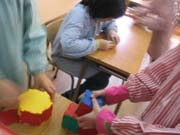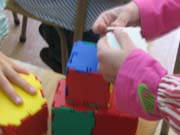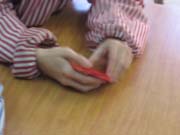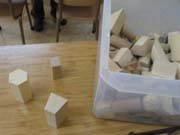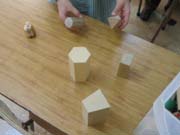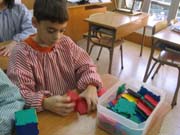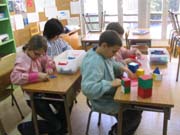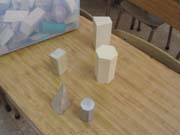PRISMS
AND PYRAMIDS
ESCOLA SADAKO
BARCELONA
LESSON
1: Recognition and definition 
Purpose:
· Revise the previous knowledge about prisms and pyramids.
· Build these solid figures with different materials
· Analise characteristics of these solids related to faces, edges and vertices.
Materials:
· POLYDRON
Vocabulary:
· Prisms and pyramids
· Tridimensional figures, plane figures, polygons
· Faces, vertices, edges and bases
Introduction:
The teacher asks the pupils to build prisms and pyramids with POLYDRON pieces, without any explanation, only remembering the previous experiences they had with these 3-D figures.
Main part:
The teacher asks the pupils to classify the solid figures made by the children into prisms or pyramids. After classifying the easiest examples with the teacher they look at the remaining figures in more detail (an octahedron, a triangular prism, a cube) and come to the conclusion that more accurate definitions are necessary.
Roundup:
Following the observations made a correct definition of both prisms and pyramids are reached. This definition is used to classify the remaining solids which were still unclassified.
Observations:
The pupils find it
difficult to see the need to take into account more than one attribute
to define the solids.
Children of this age are more able of visualising the geometrical information
rather than expressing it in words.
Purpose:
· To identify solids from the definitions elaborated in the previous lesson.
Materials:
· The geometrical solids box
Vocabulary:
· Prisms and pyramids
· Faces, vertices, edges and bases
· Triangles, quadrilateral pentagons,…
Introduction:
The teacher asks the pupils to take prisms and pyramids out of the box. The class judges the selection in accordance with the previous definitions. Then the pupils make sure that no prism or pyramid is left in the box.
Main part:
The teacher asks
the pupils to identify among the already selected solids those that have
a certain number of faces, edges or vertices which the teacher mentions
in each situation.
During this activity children are encouraged to match the number of faces,
edges and vertices of a solid to the base shape (e.g. a pentagonal prism
has 5+5+5 edges, 5+2 faces and 5+5 vertices).
Roundup:
Confirm the necessity of mentioning different attributes of a solid when we define it and also when we classify it (e.g. a cube or a very low prism).
Observations:
Children find it
difficult to classify as prisms or pyramids solids that don’t have
regular polygons as a base. On the other hand the same occurs when they
have to refuse pyramids.
Some children establish patterns between the number of edges and vertices
with the number of sides of the polygons in the base (e.g. in a prism
the number of edges is the triple of the number of polygons sides).
Purpose:
· To identify and mention the characteristics of each solid related to the faces, edges and vertices.
Materials:
· Worksheets to write down the observations
Vocabulary:
· Prisms and pyramids
· Vertices, edges and faces (lateral faces and bases)
· Triangles, quadrilateral, pentagons
Introduction:
The teacher asks the children to take out the solids they have worked on in the previous lesson. The observation worksheets are shared out and read in order to decide the main aims of the lesson.
Main part:
When the children
fill in their worksheets they can manipulate the materials at the same
time.
The teacher follows the process speaking with the pupils who have difficulties
to carry on their work and challenging those who can leave the materials
aside and do it mentally.
Roundup:
The observations made by the pupils are shared and they generalise the relationship between the lateral faces and the bases of the observed solids with the help of the worksheets.
Observations:
Some children can reach beyond others and relate the number of edges and vertices of each solid.
